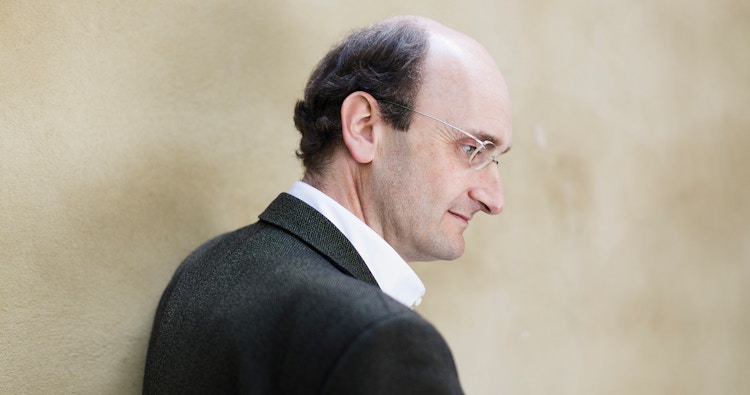Bach Bartok Brahms
Imaginative Forms from the Past

Conductor Andrew Manze. Photo: Benjamin Ealovega
Imaginative Forms from the Past
Andrew Manze conducts music by Johann Sebastian Bach, Béla Bartók and Johannes Brahms.
For many, Bach's music is timeless and universal. Edward Elgar must have shared these feelings when he arranged Bach's organ piece Fantasy and Fugue for orchestra, although he also left his own mark on the work. Brahms too made a reference to Bach at the conclusion of his symphony cycle, using the Passacaglia as an anchor in the mighty finale of his Symphony No. 4. Andrew Manze conducts, and Kristof Barati is the soloist in Bartók's Violin Concerto No. 2 − based on love of one's country, freedom, and the infinite possibilities of the variation form.
Johann Sebastian Bach (1685−1750) has written great music for most instruments and occasions − and his organ music is no exception. In Fantasy and Fugue, one of the freest and one of the strictest musical forms Bach had at his disposal, meet. The fantasy was intended to give an impression that the music had been improvised. In the fugue, by contrast, there were clear guidelines for how the melodic ideas should be treated and how the tonal progression should be organised. Bach was a master of both and filled both the fantasy and the fugue with intricate multiple voices and a richness of ideas.
Edward Elgar intended to collaborate with Richard Strauss in the 1920s on arranging Bach's Fantasy and Fugue in C-minor (BWV 537) for orchestra, but Elgar ended up completing the job on his own, and ensured that it received its world premiere in Gloucester in 1922. He has retained the organ's surging richness of sound, but has at the same time evoked the same glowing palette of colours that he used in his own works.
Another composer who mastered both free and strict forms to the utmost was Béla Bartók (1881−1945), who had a special interest in the different forms of variations. When he wrote his second violin concerto in the 1930s, he had planned the whole work as one variation movement, but Zoltán Székely, who performed the world premiere of the concerto in Amsterdam in 1939, wanted three movements. Still, the work is characterised by the variation form, especially in the second movement, where a lyrical theme is sustained through six variations.
Bartók's interest in Hungarian folk music also shines through the work, such as in the rhapsodic opening melody which soars over the plucking of the harps and strings. The concerto is composed at the same time and in the same spirit as the violin concertos of Berg and Szymanowski, but has a distinctive style, which could only have been produced by Bartók. The work was the composer's best known violin concerto until another was published post-humously, and the concerto in question had to be rebaptised Violin Concerto No. 2.
The third master of form in this programme is Johannes Brahms (1833−1897). In an era which witnessed aesthetic debates on to what extent music could, should and ought to express something outside itself, Brahms was a prime example of that music was simply, in Eduard Hanslick's words, “sound forms in movement”. Brahms' strategy of form built on that of Beethoven, and used minor motifs as a starting point for an advanced development over a period of time, often in cyclical structures.
Brahms' four symphonies have, like Bach's music, gained a permanent place in the standard classical repertoire, and listeners new and old are still constantly astonished by the power of these tones. The opening theme in his fourth symphony ventures forwards tentatively, setting in motion a spectacular process which only gains in intensity in the dramatic first movement. The two middle movements reveal other aspects of the composer. The second movement is cautious, simple and affectionate, while the third movement constitutes the only real scherzo in all his four symphonies. Still, the highlight of the symphony is the mighty passacaglia in the final movement, where a “Bach-like” theme forms a framework for some of Brahms' most impressive and dramatic symphonic structures. Brahms' fourth symphony was first performed in Meiningen in 1885.
(In photo: Andrew Manze, Photo: Benjamin Ealovega; Text: Thomas Erma Møller; Translation from Norwegian: Sarah Osa)
What is played
- J.S. Bach Fantasia and Fugue in C minor BWV 537 (arr. Elgar)
- Béla Bartók Violin Concerto No. 2
- Johannes Brahms Symphony No. 4
Duration
Performers
-
Andrew Manze
Conductor -
Kristof Barati
Violin
Tickets
Prices
| Price groups | Price |
|---|---|
| Adult | 100 - 470 NOK |
| Senior | 100 - 375 NOK |
| Student | 100 - 235 NOK |
| Child | 100 NOK |
Subscription
Bach Bartok Brahms